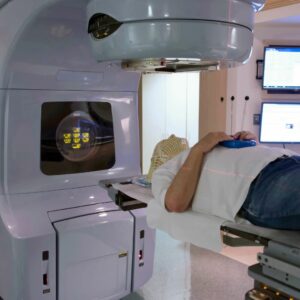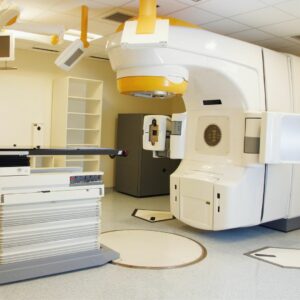Table of Contents
- Introduction
- What is Stereotactic Radiosurgery?
- Types of Stereotactic Radiosurgery
- How Does Stereotactic Radiosurgery Work?
- Indications for Stereotactic Radiosurgery
- Advantages of Stereotactic Radiosurgery
- Limitations and Potential Complications
- Future Directions and Implications for Clinical Practice
- Conclusion
Introduction
Stereotactic Radiosurgery (SRS) is a highly precise form of radiation therapy used to treat various neurological conditions, including brain tumors, arteriovenous malformations (AVMs), and trigeminal neuralgia. Unlike traditional surgery, SRS does not involve making an incision or removing tissue, making it a minimally invasive alternative. In this article, we will provide an in-depth overview of SRS, including its types, indications, advantages, limitations, and future directions. If you have any further questions on SRS after completing this article, be sure to contact Dr. Symeon Missios to learn more!
What is Stereotactic Radiosurgery?
Stereotactic Radiosurgery (SRS) is a non-surgical technique that delivers a high dose of radiation to a specific area of the brain. It is often performed using a specialized device called a Gamma Knife, which uses multiple beams of radiation to target the area of interest. Other devices used for SRS include CyberKnife and linear accelerator-based (LINAC) SRS.
How Does Stereotactic Radiosurgery Work?

To perform SRS, a team of healthcare professionals, including a neurosurgeon, radiation oncologist, and medical physicist, work together to create a detailed plan for the procedure. This plan involves using advanced imaging techniques, such as magnetic resonance imaging (MRI) or computed tomography (CT), to precisely locate the area of interest and develop a three-dimensional map of the area.
Once the plan is in place, the patient is positioned on a specialized table and immobilized using a headframe or mask. The radiation is then delivered to the target area using a highly focused beam of radiation, such as a linear accelerator or a gamma knife. The beam is directed from multiple angles to deliver the maximum dose of radiation to the target area while minimizing radiation exposure to the surrounding healthy tissue.
During the procedure, the patient is awake and alert, and the team monitors their vital signs and neurological function to ensure that the radiation is delivered safely and effectively. The entire procedure typically takes several hours to complete, and patients are able to return home the same day.
Indications for Stereotactic Radiosurgery
SRS is used to treat a variety of neurological conditions, including:
- Brain tumors: SRS can effectively treat both benign and malignant brain tumors, including meningiomas, gliomas, and metastatic tumors.
- Arteriovenous malformations (AVMs): SRS can treat AVMs by causing the blood vessels to clot and the AVM to shrink over time.
- Trigeminal neuralgia: SRS can provide long-lasting pain relief for patients with trigeminal neuralgia, a condition characterized by severe facial pain.
- Acoustic neuromas: SRS can effectively treat acoustic neuromas, which are benign tumors that develop on the nerve that controls hearing and balance.
- Pituitary tumors: SRS can treat pituitary tumors, which are noncancerous growths that develop on the pituitary gland.
- Metastatic tumors: SRS can effectively treat metastatic tumors that have spread to the brain from cancer in other parts of the body, including lung, breast, and melanoma.
Advantages of Stereotactic Radiosurgery
Stereotactic Radiosurgery has several advantages over traditional surgery, including:
- Minimally invasive: SRS does not involve making an incision or removing tissue, making it a minimally invasive alternative to traditional surgery.
- Precise targeting: SRS uses advanced imaging techniques to precisely locate the area of interest, allowing for highly targeted delivery of radiation.
- Fewer side effects: Because SRS spares the surrounding healthy tissue, it can result in fewer side effects than traditional surgery or radiation therapy.
- Quick recovery: Patients can typically resume normal activities within a few days after SRS, compared to several weeks for traditional surgery.
Limitations and Potential Complications
While Stereotactic Radiosurgery has several advantages, it is important to consider its limitations and potential complications. These include:
- Delayed response: SRS does not produce immediate results, and it may take several months for the full effect to be seen.
- Potential complications: While rare, SRS can result in complications such as radiation necrosis (death of tissue due to radiation), swelling, or bleeding in the brain.
- Risk of tumor progression: While SRS can effectively treat tumors, there is a risk of tumor progression in some cases, requiring additional treatment.
- Limited size of tumors: SRS is most effective for treating small to medium-sized tumors, as larger tumors may require multiple treatment sessions or alternative treatment options.
- Cost: SRS can be expensive, and may not be covered by all insurance plans.
Future Directions and Implications for Clinical Practice
As technology continues to advance, the use of SRS is likely to increase in the future. Researchers are currently exploring the use of SRS for the treatment of other conditions, such as epilepsy and Parkinson’s disease. Additionally, improvements in imaging techniques and radiation delivery systems may further improve the precision and effectiveness of SRS.
Conclusion
Stereotactic Radiosurgery is a highly precise and minimally invasive form of radiation therapy that can effectively treat a variety of neurological conditions. While it has several advantages over traditional surgery, it is important to consider its limitations and potential complications. As technology continues to advance, SRS is likely to become an increasingly important tool in the treatment of neurological disorders. If you or a loved one is considering SRS as a treatment option, it is important to discuss the risks and benefits with your healthcare provider to determine if it is the right choice for you. If you are interested in stereotactic radiosurgery, schedule an appointment with Dr. Symeon Missios!


